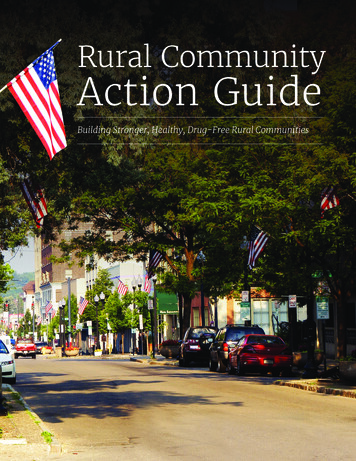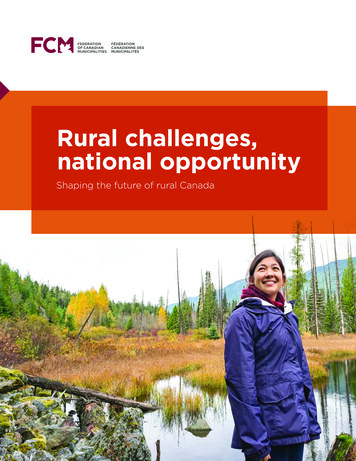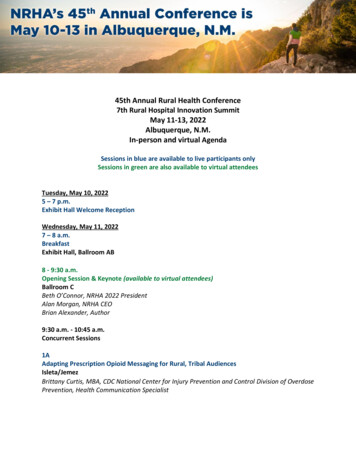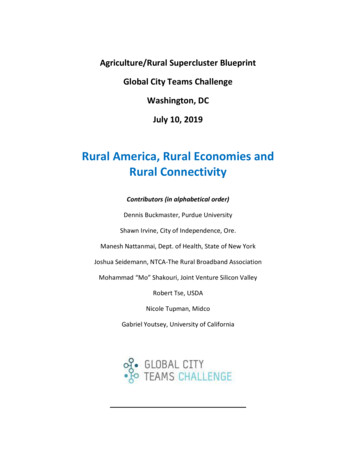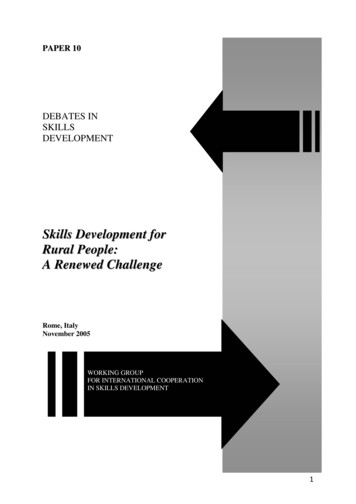
Transcription
The Nestlé Rural Development FrameworkFindings from Studies in 11 CountriesandImplications for our Future Work on Rural DevelopmentRDF Public Summary ReportPage 1 of 3028th September 2015
IntroductionRural Development is one of the areas of focus for Nestlé in its ambition to create shared value. Thereason is simple: Nestlé has a large presence in rural areas. 400 of our factories, employing 205,000people are located in rural areas and make significant contributions to rural communities. We sourcefrom 4.1Million farmers, including directly from almost 700,000 across over 50 countries. Most of theseare family farmers. It is important therefore for Nestlé that rural areas are attractive places to live, workand invest in: the overall wellbeing of farmers and their families, rural communities, small entrepreneursand suppliers are intrinsic to the long-term success of our business.Over the last few years we have developed The Rural Development Framework (RDF) to guide our workwith farmers through our Farmer Connect programmes and to inform our work on responsible sourcingthrough our trade partners. The aim of the RDF is to align business and social needs in order to ensurelong term supply of raw materials and simultaneously deliver upon our ambition to create shared value.The RDF provides a methodology that allows us to assess and prioritise any gaps in business practicesand social needs that are present in our supply chains. Following on from that, we can define fieldactivities to address those gaps and needs.An RDF baseline has been established in 11 markets since 2013. This has provided us with a consistentapproach across Nestlé Markets and an ability to measure & communicate progress and report crediblyto partners and stakeholders. In designing the RDF and through the application in the first 11 countrieswe have engaged with a series of organisations representing civil society, governments and companies.There has been considerable interest in the RDF from outside stakeholders and trade partners, which hasled us to produce this report.In September 2015 the United Nations Global Goals were agreed by the world’s governments. There is asignificant overlap in Nestlé’s work on rural development and the Global Goals – an initial assessmentindicates that our activities will contribute to 11 of the Global Goals and over 30 of the indicators.This is a good moment therefore to take stock of where we are, what we have learned to date, and toset a course for the next few years; not only in how we continue to establish baselines, but importantlyhow we operationalise the findings into the Nescafé and Cocoa Plans, our broader Farmer Connectprogrammes and work with trade partners.Our findings are not unique – they are similar to those of other surveys and government statistics. Thescale of the challenge in some countries and some topics is however significant. Whilst we have beenable to identify appropriate actions for Nestlé to undertake, collective effort is needed to solve some ofthe challenges. We are open to sharing our own insights and welcome engagement not only with thecommunities in which we operate, but with governments and other stakeholders.José LopezEVP, OperationsNestléSeptember 2015RDF Public Summary ReportPage 2 of 3028th September 2015
Summary“Nestlé has identified areas of focus where shareholders’ and society’s interests intersect, and wherevalue creation can be jointly optimised. Rural development: because the overall wellbeing of farmers,rural communities, small entrepreneurs and suppliers are intrinsic to the long-term success of ourbusiness. We aim to demonstrate and measure systematic and continuous improvement in . theseareas”. The CSV pyramid description January 2011In order to define and deliver upon this ambition, Nestlé has developed a Rural Development Framework(RDF). The RDF is first and foremost a diagnostic tool which allows us to develop an understanding of thestatus of farmers, farm workers and communities from the communities we are sourcing from. This thenallows us to identify interventions that will align business and social needs in order to ensure long termsupply of raw materials and simultaneously deliver upon our ambition to create shared value.During the last two and half years Nestlé has applied the RDF across 11 countries. This report describesthe RDF – its objectives, the various process steps, and the findings from baseline data gathered in thesefirst 11 countries. The key findings across the eight core areas that we gathered data on are:Farm EconomicsTypical farm size is 1-2 ha. Target crop typically provides 40% of income,and is often of secondary importance.Farmer Knowledge & SkillsFarmer training delivers productivity, quality & income benefits.Farm WorkersData is difficult to gather. Workers are often migrants and are in aninsecure situation. They rarely receive training.Women’s EmpowermentThe status across countries is variable. They have low access to training.Land & Land Tenure10-30% of farmers have insecure land title. More knowledge is neededon minimum economic land size.NutritionTypically in a country 30-70% of farmers are short of food for 3 monthsor more. There is poor dietary diversity.Water & Sanitation10-100% of farmers take drinking water from rivers/streams. Poorhygiene is common.Natural Resource Stewardship Key farmer concerns are: soil quality & erosion; polluted streams; andthe need for help in adapting to changing weather patternsThese findings need to be seen within the context of the overall development of the countriesthemselves, which are typically lesser developed or low-middle income countries. In designing theinterventions to respond to the findings it is important to recognize that there are many actors, of whichNestlé is just one. Whilst Nestlé can define individual interventions for its supply chains, many of theproblems and challenges need collaborative action and partnerships. There is also a limit to the rolesthat a company or companies can play, and so actions by Governments are still crucial on topics such asland. The RDF has also highlighted the need for a discourse amongst the development community on thereliance upon certification to deliver development outcomes.The findings have now shaped a roadmap for the next few years for Nestlé’s work on rural development,both in terms of improving the RDF process itself and in designing national and global interventions. Atthe national level the individual country reports will help define the interventions. Complementing thisthere will be a global focus upon improving farm economics and the nutrition security of communities.RDF Public Summary ReportPage 3 of 3028th September 2015
Table of ContentsIntroduction2Summary3Table of Contents4Glossary of Terms & Global Data Sources5Part IBackground and Objectives6Diagnostic Process12Summary Findings14The Process14Results15Part IIA Roadmap for Future Activities on Rural Development19Future Business Baselines19Responses19Next Steps23A Broader Discourse25Appendix ICountry SummariesRDF Public Summary Report27Page 4 of 3028th September 2015
Glossary of TermsCSV: Creating Shared Value – the idea of simultaneously creating value for shareholders and societyFarmer Connect: Nestlé’s direct sourcing programme that provides technical support for farmersthrough Nestlé’s own network of agronomistsNescafé Plan: The Nescafé Plan is a global initiative that brings together our commitments and activitiesthat support the responsible farming, production and supply, and consumption of coffee.Cocoa Plan: The Nestlé Cocoa Plan aims to improve the lives of cocoa farming communities and thequality of the cocoa we purchase.Global Data SourcesThe global context data was taken from a variety of publications by:The Food and Agriculture Organisation (FAO)World Bank, United Nations Development Programme (UNDP)World Health Organisation (WHO)United Nations Children’s Programme (UNICEF)United Nations Cultural Organisation (UNESCO)International Trade Union Confederation (ITUC)Millennium Challenge CorporationWorld Economic ForumThe Economist Intelligence UnitThe Global Alliance for Improved Nutrition (GAIN)The World Resources InstituteRDF Public Summary ReportPage 5 of 3028th September 2015
Part IBackground & ObjectivesNestlé has worked closely with farmers since its creation almost 150 years ago, and recognizes theimportant role that farmers, both large and small, play in supplying it with high quality raw materials.Nestlé today has a team of over 1000 agronomists and 10,000 agricultural extension staff worldwidewho work to develop the supply of raw materials and support the farmers that supply us1.Through programmes such as the Nescafé Plan, the Nestlé Cocoa Plan, the Nespresso AAA Program andour other Farmer Connect (direct procurement) work with dairy farmers and other crops, our focus hashistorically principally been upon supply chain interventions – the provision of better inputs (eg higheryielding plantlets), farmer training on agronomy, animal husbandry and business practices. Farmers whohave received this support have improved yields and incomes, and improved livelihood outcomescompared to those who have not (see box).Observed impacts of Nescafé Plan, based upon baseline data gathered during 2013/2014See Results section on page 14 for further explanationOutcomes from Nescafé Plan, KenyaSource RDF report, SolidaridadAverage yield per CoffeeTree in kgsAverage months for food insecureTree part of Nescafe PlanNescafe Plan farmerTree not part of NescafePlanNot part of NescafePlan0.1.252.53.755.0.0.61.21.82.4Outcomes from Nescafé Plan, MexicoSource RDF report, Technoserve Farmer Net Income: 95% higher than control groupFarmer Knowledge & Skills: 100% higher productivity and higher adoption levels across most keyskills areasNutrition: 35% fewer skipped meals than control groupNestlé has long understood the need to support farmers beyond supply chain interventions and toaddress “context” factors such as empowering women or investing in clean water and sanitation. A1See www.nestle.com for further informationRDF Public Summary ReportPage 6 of 3028th September 2015
variety of existing activities address such issues as part of voluntary certification standards. A similarapproach is followed by our trade partners, many of whom also look to Nestlé for guidance on where tofocus their support programmes.In order to better guide the actions of multiple initiatives supporting farmers Nestlé developed the RuralDevelopment Framework (RDF). This sets out to: Deliver a consistent global approach and ambition across Nestlé whereby we identify andaddress locally relevant issues whilst also contributing to global development prioritiesAlign the business with these societal priorities, by setting priorities to create shared value at amarket level based upon gaps identified from gathered information, and by designing our fieldactivities to deliver upon theseProvide a credible process with partners, that can measure and communicate progress andactivities and resultsThe RDF was developed with the help of Solidaridad, Rainforest Alliance, the Fair Labor Association andthe Danish Institute for Human Rights and has been socialized with a variety of other specialiststakeholders who have also provided inputs to its development. It blends a development and humanrights approach to the challenges faced in rural areas. It focuses upon three separate but connectedgroups: farmers, workers and communities. The goals that we seek for these different groups are that:Farmers are business orientated and farming by choiceRural based employment is attractive for workersCommunities are progressing economically, environmentally & sociallyUltimately, we would like to see rural areas that are attractive places to live, work and invest in.The RDF is thus a diagnostic tool to be used across key sourcing regions to assess the status of farmers,farm workers and communities who provide agricultural raw materials to Nestlé businesses fromsmallholder systems. The RDF has been designed specifically for small-holder farming, both through ourFarmer Connect operations as well as through our procurement through trade partners. We aretargeting countries that are important sourcing origins for Nestlé and where there is a high social need(as defined by low Human Development Index, high Global Hunger Index and high Inequality2).We recognize that it is not the responsibility of business to solve social needs. Nestlé is a business, and isonly one actor amongst many within a country. Our sphere of influence and responsibility is different tothat of governments, communities themselves and other actors. Governments have a duty to deliverservices such as clean drinking water and the role of companies is limited to a responsibility to notcompromise these services. Nevertheless, it is clear that in some countries and situations companiesmay need to cross these boundaries, and in doing so it is possible to create shared value for shareholdersand society. This is the underpinning for the concept of Creating Shared Value.We have identified eight core areas which we believe are important elements of successful ruraldevelopment that Nestlé should focus upon. The eight core areas are composed of two that directlyaddress farmers, one on workers and a further five that address community level topics (accepting thatfarmers and workers are themselves part of a community). We do not pretend that these are the only2UNDP, IFRPI & Gini IndexRDF Public Summary ReportPage 7 of 3028th September 2015
aspects that are important to development, but they are the ones where we believe that Nestlé canbring some expertise (directly or through partners) to deliver improved outcomes to rural development.To provide important context information, the graphs in this section illustrate the scale of the challengesat national levels. The data are taken from global publicly available sources.They eight areas are:1. Farm EconomicsUltimately by improving farm householdeconomics we expect to make farming attractive.Farm economics is dependent upon a widevariety of factors: productivity; quality; costs ofproduction and price premiums (for achievingquality or sustainability standards)*. We alsorecognize the importance of the “farm system” –that is that the target crop may not be the onlycrop grown and commercialized.*Price is a significant element of farm economics,though not one over which a company can have asignificant impact. Supply – demand dynamicsand the role of commodity markets largelydetermine price movements. We have purposelytherefore excluded pricing as a lever upon which we will concentrate.Data for Poverty Headcount graph from the World Bank2. Farmer Knowledge & SkillsFarmer knowledge and skills are a key area tofocus upon to drive productivity, tradingrelations, cost control and management of thefarm as a small business. The provision oftraining is not the objective, rather the uptakeof the learning from training and application ofbest practices.Data for the Mean Years of Schooling graphfrom UNDPRDF Public Summary ReportPage 8 of 3028th September 2015
3. Farm WorkersWe believe that it is not only important to focusupon farmers, but also the farm workers thatprovide the permanent and casual labour,primarily at harvesting season, though oftenthroughout the year in larger farms. Oftencomposed of migrant labour and often “invisible”through traditional support programmes, theattractiveness of farming requires also that farmwork is attractive.Data for Workers Rights from ITUC4. Women’s EmpowermentGender equality is at the heart of the humanrights. In addition to understanding the proportionof male and female farmers that supply us, thereare four areas that we believe are important togain insights on to guide our work: the role ofwomen in society and the family; access toservices and assets (such as training, finance, land);the tasks undertaken by women on the farm;income levels and sources of income.Data for Gender Empowerment from UNDP5. Water & SanitationWater is one of the priority areas of focusunder our approach to business: CreatingShared Value. Nestlé supports the humanright to water and has signed the WorldBusiness Council for SustainableDevelopment (WBCSD) WASH pledge. Weare committed to assist the provision ofclean water and improved sanitation topriority communities where Nestlé issourcing agricultural commodities.Data for Improved Water Source andSanitation Facilities from WHO/UNICEF(World Bank)RDF Public Summary ReportPage 9 of 3028th September 2015
6. NutritionNutrition is the other key priority areaunder our Creating Shared Value approach.We have focused our efforts to gatherinformation on nutrition security throughtwo internationally recognizedquestionnaires – Mean Annual HouseholdFood Provision and Dietary Diversity Score3.The former provides an overview of themonths of the year that farmers are shortof food. The latter is a quick measure ofhow balanced the diet is.Data for Stunting & Wasting/Global FoodInsecurity Index from UNICEF & EconomistIntelligence Unit7. Land and Land TenureA high proportion of small holder farmers do not have secure title to the land that they farm. This isoften a constraint upon investment in the farm as well as the ability to raise finance. A secondproblem is the lack of equality of land tenure between men and women.Data on Women Land Holders from FAO. Data on Property Rights Index from World Economic Forum8. Natural Resource StewardshipTwo levels of resource stewardship are important - the environmental performance of individualfarmers, and the collective community or landscape level actions to preserve individual humanrights. For management of natural resources to be effective, actions are frequently required at both3Questionnaires developed by USAIDRDF Public Summary ReportPage 10 of 3028th September 2015
levels. We are focusing upon four areas: water (water tables and surface water quality),deforestation, soil management (erosion, contamination, health) and biodiversity (IUCN red listspecies, biodiversity connectivity in fragmented landscapes).Data on Climate Change from GAIN. Data on Fertilizer Consumption from FAO/World BankWe accept that in some countries some of these eight core areas may not be relevant and someadditional areas may be more important. The RDF process allows for adjustments to this list, asdescribed below.The Broader ContextComparing the eight focaltopics and the proposed workon rural development againstthe Global Goals (formerlythe Sustainable DevelopmentGoals) indicates that as Nestléimplements findings from theRDF work it will contribute to11 of the Global Goals and 32of the individual indicators.Contribution to UN Global Goals*Farm EconomicsFarmer Knowledge & SkillsFarm WorkersGenderLand & Land TenureNutritionWater & SanitationNatural Resource StewardshipEnd Poverty, Sustainable AgricultureLife Long Learning, Decent WorkDecent Work, Inclusive SocietiesGender Equality & Empower WomenEnd PovertyEnd HungerAvailability of Water & SanitationClimate Change, Natural Resource Use* Selection only: Full list of Global Goals 1,2,3,4,5,6,8,12,13,15,16. (32 indicators)RDF Public Summary ReportPage 11 of 3028th September 2015
Diagnostic ProcessDuring 2013 we carried out three pilot applications of the RDF to establish baseline data sets in Vietnam,China and Côte d’Ivoire. From this experience we have been able to develop the following approach thatwe are currently using.Step 1. Country Briefing: this is a desk research using existing publicly available information eg UnitedNations Development Programme (UNDP), World Bank. This is complemented by outside views fromNGOs and other stakeholders. This allows us to confirm the scope of the RDF (the eight areas) and adjustit accordingly. In Côte d’Ivoire for example we extended the scope to include child labour and education.Step 2. Livelihood Zoning4: this is a stratificationprocess that considers different geographies andfarming systems, to describe different “livelihoodzones”. Typically there are 4-10 different livelihoodzones in each country. This allows us to clusterfarmers according to the role & significance of thetarget crop plays and the farming system that theyemploy. It helps to stratify sampling for the fieldsurvey and to be more selective on the datagathering. Ideally this includes somemethodological exercises like constructing aseasonal calendar, in order to understand if thereare economic, social or environmental variances indifferent farming areas. See example fromPhilippines.Step 3. Data Collection: here we collectinformation from communities, farmers and farmworkers. This step is carried out by a 3rd party,preferably local. The purpose is to gather missinginformation and verify the information collectedduring step 2. In this step we also rely on existingdata where it is available. We have a comprehensive questionnaire with over 200 questions. In gatheringthe data we focus wherever possible upon data gathering at the community level – this is particularly thecase for women’s empowerment, water & sanitation, nutrition, land & land tenure and natural resourcestewardship.Step 4. Response: After the analysis of the data is completed by the 3rd party, the main findings arediscussed by the technical teams at the Head Office and at the country level. We jointly agree on theresponse and way forward. The response is then incorporated into the country business plan.4FEG Consulting and Save the Children (2008). The Practitioners’ Guide to the Household Economy Approach, regional Hunger and VulnerabilityProgram, JohannesburgRDF Public Summary ReportPage 12 of 3028th September 2015
Business objectivesWe have deliberately named this process as a framework. This is to ensure that there is flexibility toaccommodate the different social contexts, different approaches to farming and the different businessneeds. As previously noted, we expanded the analysis in Côte d’Ivoire to cover other social issues.The RDF has also proven to be flexible enough to accommodate different business needs. In China theRDF helped us frame a study to understand better the needs of existing farmers in order to help buildtrust. In Myanmar we do not have operations, so the RDF exercise was very much about collecting abroad understanding of the current status and capabilities of farmers. In other countries such asVietnam, Mexico and Côte d’Ivoire where our Farmer Connect activities are expanding the RDF hashelped us define our strategy.We have currently only applied the RDF to small-holder farming situations. For larger family andcommercial farms typical of dairy, or coffee in Brazil, a full RDF process may not be appropriate. Largerfarms often do not face the basic development challenges of smallholders – for them the challenges areto streamline and improve existing practices, and for this our current approach uses a tool called RISE(see nestle.com for further details). Nevertheless, the livelihood zoning element could be a usefuladdition to the RISE assessment.Understanding the BaselinesWe have designed the RDF as a diagnostic tool to understand the status of the farmers, farm workersand communities from whom we source (or whom we can potentially source from). In this designprocess we were conscious of the different approaches to M&E (monitoring and evaluation). Theapproach we have taken is essentially about “performance measurement”, not “impact assessment”.Whilst we wish to have an impact in our operations, the speed and fluidity of the business decisionmaking is such that we did not wish to have control groups or statistically driven evaluations.The baselines therefore are designed to identify gaps (across the business and social aspects prioritized)based upon gathered data and in
RDF Public Summary Report Page 5 of 30 28th September 2015 Glossary of Terms CSV: Creating Shared Value - the idea of simultaneously creating value for shareholders and society Farmer Connect: Nestlé's direct sourcing programme that provides technical support for farmers through Nestlé's own network of agronomists Nescafé Plan: The Nescafé Plan is a global initiative that brings .



